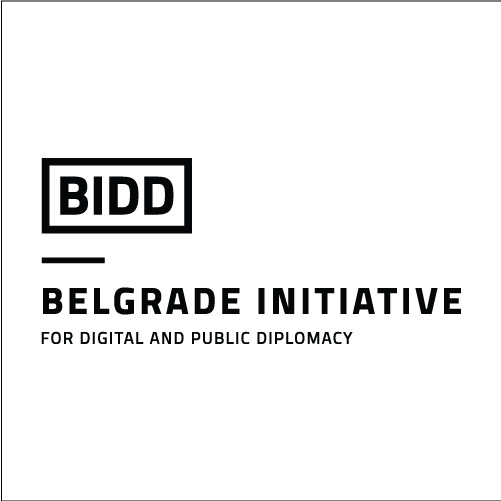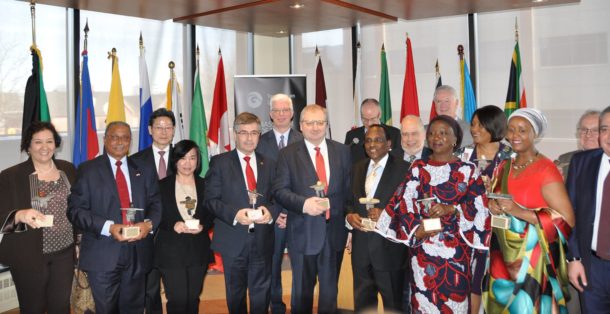link.springer.com
The Digitalization of Public Diplomacy pp 65-99| Cite as Image (not from article) from
Image (not from article) from
- Ilan Manor

- 1.
Chapter
First Online: 15 January 2019Part of the Palgrave Macmillan Series in Global Public Diplomacy book series (GPD)
Abstract
This chapter offers a series of case studies demonstrating how the characteristics of digital publics have challenged diplomats’ norms, working routines and communicative cultures. The chapter is structured chronologically, so as to demonstrate that the digitalization of public diplomacy [JB emphasis] did not occur in one day, nor was it the result of a single digital interaction. Rather, the digitalization of public diplomacy has been a long-term process in which digital technologies, digital publics and digital initiatives have all impacted the conduct of public diplomacy. The chapter illustrates the digitalization of American public diplomacy, before examining the digital initiatives of the governments of Hamas, Israel, Sweden and the EU. Each case study demonstrates the manner in which interactions between digital publics and diplomats have shaped the digitalization of public diplomacy.
This is a preview of subscription content, log in to check access.References
- Abbasov, A. (2007). Digital diplomacy: Embedding information and communication technologies in the department of foreign affairs and trade. Retrieved from https://www.academia.edu/1058526/Digital_Diplomacy_Embedding_Information_and_Communication_Technologies_in_the_Department_of_Foreign_Affairs_and_Trade.
- Adesina, O. S. (2017). Foreign policy in an era of digital diplomacy. Cogent Social Sciences, 3(1), 1297175.CrossRefGoogle Scholar
- Ahren, R. (2017, September). More Israelis like the EU than dislike it, poll finds. The Times of Israel. Retrieved from https://www.timesofisrael.com/more-israelis-like-the-eu-than-dislike-it-poll-finds/.
- Barlow, J. P. (1996). A declaration of the independence of cyberspace. Retrieved from https://www.eff.org/cyberspace-independence.
- Bauman, Z., & Lyon, B. (2016). Remoteness distancing an automation. In Z. Bauman & B. Lyon (Eds.), Liquid surveillance (pp. 76–99). Cambridge: Polity Press.Google Scholar
- Bertot, J. C., Jaeger, P. T., & Hansen, D. (2012a). The impact of polices on government social media usage: Issues, challenges, and recommendations. Government Information Quarterly, 29(1), 30–40.CrossRefGoogle Scholar
- Bertot, J. C., Jaeger, P. T., & Grimes, J. M. (2012b). Promoting transparency and accountability through ICTs, social media, and collaborative e-government. Transforming Government: People, Process and Policy, 6(1), 78–91.CrossRefGoogle Scholar
- Bjola, C., & Manor, I. (2018). Revisiting Putnam’s two-level game theory in the digital age: Domestic digital diplomacy and the Iran nuclear deal. Cambridge Review of International Affairs, 33, 1–30.Google Scholar
- Bortree, D. S., & Seltzer, T. (2009). Dialogic strategies and outcomes: An analysis of environmental advocacy groups’ Facebook profiles. Public Relations Review, 35(3), 317–319.CrossRefGoogle Scholar
- Clarke, A. (2015). Business as usual? An evolution of British and Canadian digital diplomacy as policy change. In C. Bjola & M. Holmes (Eds.), Digital diplomacy theory and practice (pp. 111–126). Oxon: Routledge.Google Scholar
- Colvin, R. (2009, May). Obama to reach out to Muslims in Egypt speech. Reuters. Retrieved from https://www.reuters.com/article/us-obama-muslims/obama-to-reach-out-to-muslims-in-egyptspeech-idUSTRE54754920090508?feedType=RSS&feedName=ObamaEconomy&virtualBrandChannel=10441.
- Copeland, D. (2013). Taking diplomacy public: Science, technology and foreign ministries in a heteropolar world. In R. S. Zaharna, A. Arsenault, & A. Fisher (Eds.), Relational, networked and collaborative approaches to public diplomacy (pp. 56–69). New York, NY: Taylor & Francis.Google Scholar
- Cull, N. J. (2008). Public diplomacy: Taxonomies and histories. The Annals of the American Academy of Political and Social Science,616(1), 31–54.CrossRefGoogle Scholar
- Cull, N. J. (2013). The long road to public diplomacy 2.0: The internet in US public diplomacy. International Studies Review, 15(1), 123–139.CrossRefGoogle Scholar
- Haaretz. (2015, March). Ask Hamas Twitter campaign quickly backfires. Haaretz. Retrieved from https://www.haaretz.com/askhamas-twitter-campaign-backfires-1.5336781.
- Hayden, C. (2012). Social media at state: Power, practice, and conceptual limits for US public diplomacy. Global Media Journal, 11(21), 1–12.Google Scholar
- Haynal, G. (2011). Corporate diplomacy in the information Age: Catching up to the dispersal of power. In J. G. Stein (Ed.), Diplomacy in the digital age: Essays in honour of Ambassador Allan Gotlieb (pp. 209–224). Ontario: Signal.Google Scholar
- Hocking, B., & Melissen, J. (2015). Diplomacy in the digital age. Clingendael: Netherlands Institute of International Relations Clingendael.Google Scholar
- Hughes, D. J., Rowe, M., Batey, M., & Lee, A. (2012). A tale of two sites: Twitter vs. Facebook and the personality predictors of social media usage. Computers in Human Behavior, 28(2), 561–569.CrossRefGoogle Scholar
- Kampf, R., Manor, I., & Segev, E. (2015). Digital diplomacy 2.0? A cross-national comparison of public engagement in Facebook and Twitter. The Hague Journal of Diplomacy, 10(4), 331–362.CrossRefGoogle Scholar
- Khatib, L., Dutton, W., & Thelwall, M. (2012). Public diplomacy 2.0: A case study of the US digital outreach team. The Middle East Journal,66(3), 453–472.CrossRefGoogle Scholar
- Kwak, H., Lee, C., Park, H., & Moon, S. (2010, April). What is Twitter, a social network or a news media? Proceedings of the 19th international conference on World Wide Web (pp. 591–600). ACM.Google Scholar
- Lampe, G. (2018). Understanding U.S. digital diplomacy [In person].Google Scholar
- Landau, N. (2018, May). Trade and tirades: The complicated truth behind Israel’s love-hate relationship with the EU. Haaretz. Retrieved from https://www.haaretz.com/israel-news/.premium-israel-eu-ties-a-love-hate-relationship-that-s-better-than-it-looks-1.6116399.
- Lee, G., & Kwak, Y. H. (2012). An open government maturity model for social media-based public engagement. Government Information Quarterly, 29(4), 492–503.CrossRefGoogle Scholar
- Lichtenstein, J. (2010, July). Digital diplomacy. The New York Times.Retrieved from https://www.nytimes.com/2010/07/18/magazine/18web2-0-t.html.
- Manor, I. (2014, July). An Epic Q&A session. The Times of Israel.Retrieved from https://blogs.timesofisrael.com/an-epic-qa-session/.
- Manor, I. (2016). Are we there yet: Have MFA s realized the potential of digital diplomacy? Brill Research Perspectives in Diplomacy and Foreign Policy, 1(2), 1–110.CrossRefGoogle Scholar
- Manor, I., & Crilley, R. (2018a). Visually framing the Gaza War of 2014: The Israel Ministry of Foreign Affairs on Twitter. Media, War & Conflict.Google Scholar
- Manor, I., & Crilley, R. (2018b). The aesthetics of violent extremist and counter violent extremist communication. In C. Bjola & J. Pamment (Eds.), Countering online propaganda and extremism: The dark side of digital diplomacy. Oxon: Routledge.Google Scholar
- McNutt, K. (2014). Public engagement in the Web 2.0 era: Social collaborative technologies in a public sector context. Canadian Public Administration, 57(1), 49–70.CrossRefGoogle Scholar
- Melissen, J. (2005). The new public diplomacy: Between theory and practice. In J. Melissen (Ed.), The new public diplomacy: Soft power in international relations (pp. 3–27). New York: Palgrave Macmillan.CrossRefGoogle Scholar
- Mergel, I. (2013). Social media adoption and resulting tactics in the US federal government. Government Information Quarterly, 30(2), 123–130.CrossRefGoogle Scholar
- Pamment, J. (2013). Introduction. In J. Pamment, New public diplomacy in the 21st century: A comparative study of policy and practice (pp. 1–19). Abingdon: Routledge.Google Scholar
- Pardo, S. (2016, August). What does Israel think about the European Union? European Council on Foreign Relations. Retrieved from https://www.ecfr.eu/article/commentary_what_does_israel_think_about_the_european_union_7101.
- Ross, A. (2011). Digital diplomacy and US foreign policy. The Hague Journal of Diplomacy, 6(3–4), 451–455.CrossRefGoogle Scholar
- Ross, A. (2015). Hillary Clinton’s FMR innovation advisor on digital diplomacy [TV]. Retrieved from https://www.bnnbloomberg.ca/video/hillary-clinton-s-fmr-innovation-advisor-on-digital-diplomacy~582509.
- Slaughter, A. M. (2009). America’s edge: Power in the networked century. Foreign Affairs, 88, 94–113.Google Scholar
- Snead, J. T. (2013). Social media use in the US Executive branch. Government Information Quarterly, 30(1), 56–63.CrossRefGoogle Scholar
- Sotiriu, S. (2015). Digital diplomacy: Between promises and reality. In C. Bjola & M. Holmes (Eds.), Digital diplomacy theory and practice(pp. 33–51). Oxon: Routledge.Google Scholar
- Spry, D. (2018). Facebook diplomacy: A data-driven, user-focused approach to Facebook use by diplomatic missions. Media International Australia, 168(1), 62–80.CrossRefGoogle Scholar
- Taylor, A. (2015, March). Hamas #AskHamas Twitter campaign is being mocked and it hasn’t even started yet. The Washington Post.Google Scholar
- Taylor, M., & Kent, M. L. (2014). Dialogic engagement: Clarifying foundational concepts. Journal of Public Relations Research, 26(5), 384–398.CrossRefGoogle Scholar
- The Stream. (2014, July). Israeli ambassador’s #AskDermer Q&A on Gaza goes terribly wrong. Al Jazeera. Retrieved from http://stream.aljazeera.com/story/201407171922-0023936.
- The White House. (2018). President Trump says the Iran deal is defective at its core: A new one will require real commitments. Retrieved from https://www.whitehouse.gov/articles/president-trump-says-iran-deal-defective-core-new-one-will-require-real-commitments/.
- Waters, R. D., Burnett, E., Lamm, A., & Lucas, J. (2009). Engaging stakeholders through social networking: How nonprofit organizations are using Facebook. Public Relations Review, 35(2), 102–106.CrossRefGoogle Scholar
Copyright information
© The Author(s) 2019
About this chapter
- Cite this chapter as:
- Manor I. (2019) A Vocal and Volatile Online Public. In: The Digitalization of Public Diplomacy. Palgrave Macmillan Series in Global Public Diplomacy. Palgrave Macmillan, Cham
- First Online15 January 2019
- DOIhttps://doi.org/10.1007/978-3-030-04405-3_3
- Publisher NamePalgrave Macmillan, Cham
- Print ISBN978-3-030-04404-6
- Online ISBN978-3-030-04405-3
- eBook PackagesPolitical Science and International Studies







